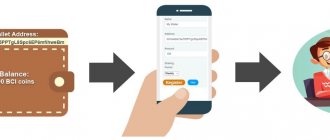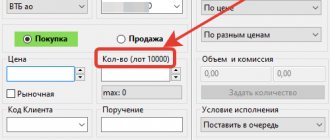The discount rate is a percentage used to match present and future cash flow amounts. It is necessary to calculate NPV (net present value), a parameter described in the article of the same name, for business and investment projects.
The discount rate is determined based on indicators such as the inflation rate, systemic and non-systemic risks, profitability of instruments, etc. Today we will look at several methods for calculating it. We will consider some of them in detail, with examples, and others we will get acquainted with in general terms. We will also talk about the differences in determining the discount rate for Russian and foreign companies.
What is a discount rate
The concept of a discount rate in simple words is best explained with an example. Let's assume you have 7,500 rubles. ($100 or 2,900 UAH), which you want to invest in 10 shares worth 750 rubles each. ($10 or 290 UAH) for each. The expected return on securities is 8% per year, and the inflation rate is 4%. Thus, in a year you will be able to receive 7,800 rubles for shares. ($104 or 3,016 UAH). This amount turned out like this:
100 + 100 * (8 – 4) / 100 = 7,800 rub. ($104 or 3,016 UAH).
The value in brackets will be the discount rate, which is calculated as the difference between the expected return and the inflation rate. In other words, the securities will bring 8% of income, 4% of which will be eaten up by inflation.
Of course, this example is quite conventional: when calculating the discount rate for an investment project, more complex methods are used and risks are taken into account. The calculation is also based on the risk-free rate. We are already familiar with this concept from the CAPM article. Let me remind you that in Russia OFZs are a risk-free instrument, in the USA - government treasury bonds.
The discount rate is a percentage calculated as the difference between the required return and the return on a risk-free instrument. Thus, the required return must be higher than the discount rate. Otherwise, the project is unprofitable.
Setting the norm
To make an investment decision, it is important to establish a discount rate that determines future income. The deposit rate is a simple example of setting a rate.
If the profitability is determined, for example, at 12%, and calculations show that the project will bring less profit, then the investor may decide to refuse to participate in the project. However, the bank rate is not always accepted as the norm. The yield of government bonds, the cost of capital, and the inflation rate can be taken as a basis.
The discount rate is influenced by internal and external factors:
- price increase rate
- change in interest on deposits and loans in banks
- market prices for company products
- economic indicators of the enterprise
- inconsistency of financial transactions within the company (delays between payment for raw materials and sales of products)
- changes in the economic environment (loan rates, taxes, wages)
These factors complicate the calculation of the discount rate. Economists advise when determining it to rely on:
- data on inflation dynamics
- economic indicators of the company
- tax rates
Where is it used?
The indicator is used for the purposes of:
- Reconciliation of cash flows in different periods.
- Assessments of investment projects and business projects. The discount factor is calculated to determine the payback period of investments, loan repayments and future cost of capital.
- Comparative analysis of investment projects.
In order to simplify mathematical calculations and eliminate errors, it is often not the rate that is used, but the discount factor. These two concepts should not be confused: the coefficient is always expressed in whole numbers, and the rate is always expressed as a percentage.
Formula for calculating the discount factor:
r – discount rate (can be determined by different methods, we will consider them further);
n is the number of periods of the project’s lifespan. Annual, quarterly and monthly rates may apply for different projects.
The discount factor characterizes the change in the value of cash flow at a certain point in time in absolute value.
Example:
R = 9%;
Project duration: 5 years.
This means that after 5 years 75,000 rubles. ($1,000 or 29,000 UAH) invested in the project will cost 123,750 rubles. ($1,650 or 47,850 UAH).
For convenience, you can use the table containing the values of discount factors in accordance with the rate:
Discounting and investment projects
This means that an investor who invests financial resources in an idea receives not engineering or human resources in the form of a group of first-class experts, new offices, bases, high-tech equipment, etc., but tomorrow’s influx of finance . If we continue to develop this topic, it turns out that various businesses “produce only one product to the market - money.
The main advantage of the method of discounting financial assets is that this method of analysis, only one of all the current ones, is aimed at market prospects, this helps the development of investment.
Calculation features
- The determination of the discount rate should be based on the concept: what income does the investor want to receive, taking into account all potential risks.
- The rate must be higher than the risk-free yield.
- Nominal and real discount rates differ: the nominal rate takes into account inflation, the real one does not. Real value of cash flows assumes constant prices and takes into account only the productivity of capital.
- The calculations involve financial reporting, stock market analysis, and statistical indicators.
Assessment methods
There are several formulas for calculating discount rates developed by economists, many of which you already know. Main factors influencing the calculation:
- dividend yield;
- inflation;
- risk premium;
- WACC;
- return on capital;
- market indicators;
- expert opinions, etc.
Next, we will consider each method for calculating the discount rate separately, if necessary, supporting the calculation formulas with practical examples.
Internal discount rate
This is the discount rate at which, after a certain period of time, the project will return the funds invested in it. However, the profit will be zero. This indicator is designated IRR. The formula for calculating this parameter is as follows:
- t – estimated time period
- IC – amount of invested funds
- CFT – enterprise financial flows
If the IRR exceeds the costs, then the project can be considered promising; if it is lower, it is better to abandon it.
Calculation
Based on the CAPM model
We have already become familiar with the CAPM model. Let me remind you that it is based on the concept of risk premium. The discount rate formula for this model is quite difficult to understand and looks like this:
Ri = Rf + β * (Rm – Rf), where:
Rf – return on a risk-free instrument;
Rm – average index return on the market;
β – tool sensitivity coefficient to changes in Rm.
σim – dispersion (deviation) of the instrument’s profitability depending on changes in Rm;
σ2m – dispersion of Rm.
Agree, not everyone knows what variance is and why it is needed. I’ll try to explain in simple terms: dispersion roughly means “distribution”, spread. That is, this is some average value of a random variable distributed over another value. There is no need to calculate it manually or using a calculator - the variance is calculated using the linear index function in Excel.
This method does not take into account important factors such as:
- taxation;
- industry specifics;
- transaction costs (transactions with instruments), etc.
According to the modified CAPM model
This model allows you to obtain a more reliable result when calculating the discount rate, since it takes into account unsystematic risk. There are several criteria that influence the degree of risk:
- seasonality;
- dependence on investors and suppliers;
- change in cost amounts;
- government regulation;
- management risk.
Each criterion is a percentage that is added to the others to form the overall risk adjustment percentage. There may not be any criterion or, conversely, additional parameters may be added for a certain industry or instrument.
The risk adjustment is denoted as Ru, and the formula is:
Ri = Rf + β * (Rm – Rf) + Ru.
According to the model of E. Fama and K. French
The three-factor model by University of Chicago professors Fama and French, developed in 1992, adds two more indicators to the modified CAPM model:
- enterprise size;
- his financial condition.
where γ is the expected return in the absence of risk factors;
si and hi are multipliers reflecting the influence of parameters Rm and Rf on the profitability of the i-th instrument;
SMBt – enterprise size (the difference between the average returns on portfolios with large and small capitalization);
HMLt is the difference between the returns on portfolios with large and small B/P indicators;
B/P is the ratio of the book value of net assets and their market price.
What is the meaning of the B/P ratio? This is the inverse indicator of P/B - the ratio of the market price of a stock to the size of net assets. The multiplier shows how much an investor is willing to pay for the company's assets upon liquidation.
And the inverse value is needed for the investor himself to understand how many times the value of the assets covers his investments.
For example, the value of assets is 1 million rubles, and the market price of shares in hand is 5,000 rubles. Then B/P = 200.
Based on the results of testing this model, it turned out that the discount rate depends on the intrinsic value indicator. Undervalued companies (with high B/P ratios) showed higher returns than large companies with overvalued shares.
Based on M. Karhat's model
M. Karhat introduced another parameter - moment. Momentum is an indicator of the rate of change in the price of an asset over a certain period of time:
R = γ + β * (Rm – Rf) + si * SMBt + hi * HMLt + WMLt, where
WMLt is the rate of change in the value of a security over the past period.
The speed indicator is determined based on graphs and is calculated as follows:
[(P/Pn) – 1] * 100, where:
P – current price;
Pn – price n periods ago.
In simple words, the discount rate is affected by the rate at which the value of the asset increases or decreases.
According to Gordon's model
We are already familiar with Gordon's model. Let me remind you that it is built on the concept of constant growth of dividend yield taking into account market capitalization.
Differences in discount rates in Russia and the West
The discount rate for Western companies is usually calculated based on the CAPM or WACC model. In Russia, these methods also work, but not so well, and here’s why.
Our economists usually determine the size of the discount taking into account risks. The most popular method is the summation of the risk-free rate and the risk premium. Due to the fact that our economy is unstable and highly dependent on foreign exchange rates, the real discount rate can reach 30–40%.
In addition, balance sheet data does not always reflect the true value of money, and the Russian stock market is subject to various fluctuations caused by external factors.
As for business projects, in Russia it is convenient to use a discount factor, which is an indicator of the real value of money in the future.
If you use the table of discount rates given just above, it is not difficult to calculate how much your investment will be worth in n years. Based on this, the payback period is calculated.
Adjusting the discount rate
In practice, the discount rate must be adjusted taking into account investment risks. To adjust, a risk percentage is added to the norm and only after that the investment efficiency is calculated. Moreover, the greater the investment risks, the greater the premium will be, the amount of which is calculated individually in each case.
Thus, for the expansion of a successful company, a risk premium can be set at 9%, for the implementation of a new project - 13%, for introducing new products to the market that require a long production and sales cycle - 25%.
If the company's initial capital was valued at 7%, then the discount rate for the above cases will be equal to 16%, 20%, 27%, respectively.
Thus, the discount rate, the formula of which is discussed in this article, is an effective economic tool for assessing the profitability of investments. Discounting helps determine profit both in simple cases, for example, in deposits, and for complex investment projects with many components (fixed and borrowed capital, tax rate, premium risks).
Top
Write your question in the form below
Advantages and disadvantages
The obvious advantage of calculating the rate and discount factor is the ability to take into account many factors affecting the future value of money: inflation, changes in exchange rates, changes in profitability, etc. Depending on the size of the enterprise, industry and type of investment project, you can choose the optimal method. It is best to calculate indicators using several methods and compare the results.
Among the disadvantages, I would note the difficulty in predicting profitability for the stock market and application for newly created companies or projects.
It should be remembered that in the activities of an enterprise there are a number of indicators that are determined without taking into account the discount rate. This is the book value of assets and the amount of depreciation charges. As we remember, these parameters are involved in the calculation of many multipliers (ROA, WACC, etc.). Thus, if you use these calculation methods, you must make an adjustment for the market value of the objects.
Approaches to calculating risk premium
Many methods for determining the discount rate include the likelihood of a shortfall in planned cash flows as a result of a force majeure situation.
The size of the risk premium is influenced by many factors.
Among them are:
- type of investment;
- the size of the company and its place in the market;
- the solvency of the organization and the degree of liquidity of its assets;
- industry affiliation and risks inherent in this industry;
- inflation;
- currency fluctuations;
- and much more.
However, there are standard approaches for determining risk. These approaches link the amount of risk and the type of investment.
- the approach set out in the “Regulations on assessing the effectiveness of investment projects when placing centralized investment resources of the development budget of the Russian Federation on a competitive basis.”
- technique .
The magnitude of the risk according to the methodology set out in the “Regulations on assessing the effectiveness of investment projects when placing centralized investment resources of the development budget of the Russian Federation on a competitive basis”
| Magnitude of risk | Sample Project | Risk premium, % |
| short | investments during intensification based on mastered technology | 3–5 |
| average | increasing sales volume of existing products | 8–10 |
| high | production and marketing of a new product | 13–15 |
| very tall | investment in research and innovation | 18–20 |
Amount of risk according to the methodology
| Characteristics of the source of project risk | Risk premium, % | WACC + risk premium, % |
| project supporting production | 0 | 18 |
| expansion of production | 3 | 21 |
| entering new markets | 6 | 24 |
| related business areas (new product) | 9 | 27 |
| new industries | 12 | 30 |











